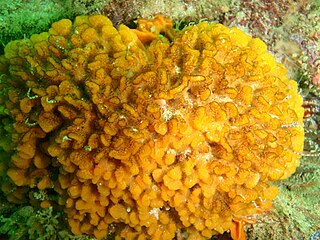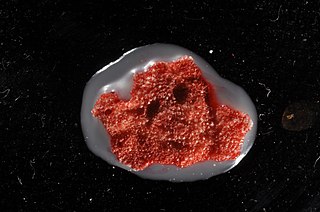
Bryozoa are a phylum of simple, aquatic invertebrate animals, nearly all living in sedentary colonies. Typically about 0.5 millimetres long, they have a special feeding structure called a lophophore, a "crown" of tentacles used for filter feeding. Most marine bryozoans live in tropical waters, but a few are found in oceanic trenches and polar waters. The bryozoans are classified as the marine bryozoans (Stenolaemata), freshwater bryozoans (Phylactolaemata), and mostly-marine bryozoans (Gymnolaemata), a few members of which prefer brackish water. 5,869 living species are known. At least two genera are solitary ; the rest are colonial.

Cheilostomatida, also called Cheilostomata, is an order of Bryozoa in the class Gymnolaemata.

A zooid or zoöid is a single animal that is part of a colonial animal. This lifestyle has been adopted by animals from separate unrelated taxa. Zooids are multicellular; their structure is similar to that of other solitary animals. The zooids can either be directly connected by tissue or share a common exoskeleton. The colonial organism as a whole is called a zoon, plural zoa.

Schizoporella unicornis is a species of bryozoans in the family Schizoporellidae. Species have been found intertidally around oyster beds in Georgia. However, the origins of this species are likely from British Columbia.

Reteporella grimaldii is a species of bryozoans in the family Phidoloporidae.

Reteporella is a genus of bryozoans in the family Phidoloporidae.
Stomatoporina is a genus of stenolaematan bryozoans. The type species is Stomatoporina incurvata. Like almost all bryozoans, it is colonial.

Conopeum seurati is a species of colonial bryozoan in the order Cheilostomatida. It is native to the northeastern Atlantic Ocean, the North Sea and the Mediterranean Sea. This species has been introduced to New Zealand and Florida.

Catenicella is a genus of marine bryozoans belonging to the family Catenicellidae. Bryozoans are colonial animals that live in aquatic environments, and Catenicella is no exception. Members of this genus are found in oceans around the world, with a particularly high diversity in the Arctic and Antarctic regions.

Fenestrulina is a genus within the bryozoan order Cheilostomatida. It is the only member of the family Fenestrulinidae. It has a world-wide distribution.

Beania magellanica is a species of colonial bryozoan in the family Beaniidae. It has a cosmopolitan distribution, occurring in shallow waters in the Atlantic and Pacific Oceans and in Antarctica.
Beania is a genus of bryozoans belonging to the family Beaniidae.
Chaperiidae is a family of bryozoans belonging to the order Cheilostomatida.
Bryocryptellidae is a family of bryozoans belonging to the order Cheilostomatida.
Romancheinidae is a family of bryozoans belonging to the order Cheilostomatida.

Gigantopora is a genus of bryozoans belonging to the family Gigantoporidae.
Antarctothoa is a genus of bryozoans belonging to the family Hippothoidae.
Lagenipora is a genus of bryozoans belonging to the family Celleporidae.

Rhynchozoon is a genus of bryozoans belonging to the family Phidoloporidae.
Reptadeonella is a genus of bryozoans belonging to the family Adeonidae.










